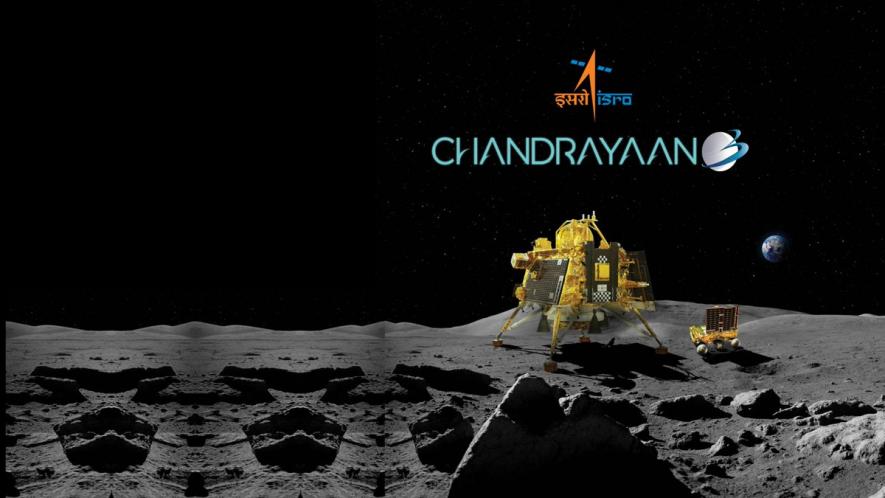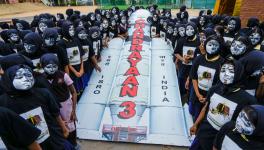After Chandrayaan-3 What? New Equations in Space

Image courtesy: ISRO/Twitter
Suddenly it feels as if every space-faring nation is heading to the Moon! India’s Chandrayaan-3 will hopefully succeed in executing a soft landing on August 23. In a rather sudden decision, the long-postponed Russian Luna 25 mission, also for soft landing of a lander, was given the green signal and launched on August 10, on a direct path to the moon.
The main objective of both missions is to prove the technologies and systems for soft landing, even though the erstwhile USSR had accomplished this almost 45 years ago, but with many failures and some possible loss of institutional memory since then. At the time of writing, the Russian mission had ended in failure after Luna 25 crashed on the moon’s surface on August 20.
If Chandrayaan-3 goes well, that will be the only topic of discussion for quite some time, along with all sorts of claims of “firsts” that India has achieved, beating other more advanced countries and joining the club of leaders in space. As argued in an earlier article in these columns, the accompanying jingoism and premature boasting had come in the way of a sober discussion of the opportunities and risks of space ventures, and of the many capabilities but also weaknesses of India’s space programme.
So, while calm prevails before Chandrayaan-3’s landing date, this is a good time to step back a little and review the unfolding scenario around moon missions by different countries and also by, or with major involvement of, various commercial entities. It may also be highlighted that the current rush to the moon over the past decade or so needs to be understood not just in terms of scientific and technical accomplishment, but also in relation to a combination of national and great power ambition, new or renewed space exploration aspirations spurred by a growth of technological capabilities among newer players, and the potential opening up of space, notably the moon, to commercial exploitation by countries and corporate entities, a new and worrisome factor.
Thaw in Cold War
Early Soviet successes in moon mission scared the US, just as the pioneering launches of satellites and then of cosmonauts had done earlier, and prompted it to ratchet up its lunar efforts, including the audacious plan and promise to land humans on the moon.
After the pathbreaking Apollo 11 moon landing, and the next few Apollo missions, dwindling US interest in crewed moon landings, whose shock and international prestige value were now bringing marginal returns, saw the Apollo programme being wound up after Apollo 17 in 1972. After this, the US only carried out a series of flyby’s and orbital missions for various scientific purposes, while it turned its attention to uncrewed missions to other planets, robotic landings on Mars, deep space exploration and the like.
The Soviet Union, now relieved from the costly pressure of the Cold War rivalry in space, continued for a while with robotic missions to the moon, having earlier achieved the first impact on the moon during Luna-2 in 1959, the first images of the far side of the moon also in 1959, and various attempts at flyby’s, soft landings and return of lunar material to earth, several of them unsuccessful at launch, during lunar orbit or during soft landings. The last Soviet moon mission was in August 1976 when Luna 24’s lander successfully brought back some moon soil.
The USSR and later Russia continued with their own Space Station, Mir or peace, and later, after the end of the worst phase of the Cold War, collaborated with the US in the International Space Station programme in partnership with the EU, Japan and Canada. Given the suspension of NASA’s rocket launcher programme due to slashing of its budget, most of the multi-nation inter-changing crews were ferried to and from the ISS by Russian launchers.
This remarkable phase of international collaboration, despite periodic flare-ups of tensions between Russia and the US with its allies in tow, lasted over 24 years since the ISS was assembled in 1998 in low-earth orbit 400km above the earth. The ISS, visible to the naked eye from earth, is the largest satellite orbiting the earth and, as far as we know, the largest artificial object in space. This collaboration is now suspended because of the Ukraine war and the sanctions against Russia by Western countries led by the US, highlighting the geo-political tensions once again, after the Cold War period, looming over the space domain.
New Scenario
After a long hiatus of almost 12 years between 1978 and 1990, during which period various aspiring nations stepped up their efforts to fill the void left by the rival superpowers, Japan’s Hagorono spacecraft intended for a lunar flyby failed and its Hiten spacecraft was inserted into lunar orbit in January 1990 and finally de-orbited and crashed on the moon in 1993, making Japan the third country to have made contact with the moon, in whatever manner.
The European Space Agency (ESA) sent up SMART-1 in September 2003 to orbit the moon, with the spacecraft crashing on to the lunar surface at the end of its mission. China’s Chang’e-1 similarly crashed on to the moon in March 2009 after starting in lunar orbit in September 2007. India’s Chandrayaan-1 entered lunar orbit in October 2008 and released a lunar impact probe which crashed on to the moon in November 2008, allowing the orbiter to study the plume of lunar dust released on impact. The spacecraft was deactivated about a year later, bit still remains in orbit.
This upsurge of activity around the moon may be ascribed to the successes already achieved by these countries in low-earth orbital activities, remote-sensing and communication satellites, and other robotic missions for example to Mars with an impact probe in the case of India and Japan’s soft landing on an asteroid, deploying many tiny rovers to collect and bring back rock samples.
Moon missions seemed the next logical goal to demonstrate these countries’ growing space capabilities, make an impression on the world especially in the geo-strategic sphere, and narrow the gap between these aspirant nations and the established and leading space powers.
Two other attempts at soft landings after this above period deserve special note. The first, of course, was Chandrayaan-2’s unsuccessful attempt at a soft landing in 2019. This followed from an earlier Mangalyaan mission with an orbiter and an impactor probe. As briefly recounted in a recent article in these columns, two more attempts at a soft landing by Japan and Israel around the same time failed.
There is no doubt that India has done exceedingly well in its space efforts, especially in low earth orbit earth-observation satellites, later developing a slightly heavier launcher enabling placing four-tonne payloads, such as communication satellites, in geosynchronous orbits or, through slingshot maneuvers conducting lunar missions. India has punched considerably above its weight.
Growing Chinese Capability
While Chandrayaan-1 reported significant findings regarding the presence of water ice on the moon, and Chandrayaan-2’s orbiter is still going around the moon and sending back valuable data, not to mention Mangalyaan, China’s Chang’e (moon goddess or princess) missions have also been successful. Chang’e-3 made a soft landing in 2013 and deployed the Yutu-2 (jade rabbit) and, in 2018, Chang’e 4 made the first ever landing on the far side of the moon.
Significantly, six months ahead of the Chang’e-4 mission, the Queciao orbiter was placed successfully in a “halo” orbit around the earth-moon Lagrange point L2 on the far side of the moon but visible to both the Change’e 4 lander and Earth. This is necessary since there is no line of sight between the earth and the far side of the moon, so the lander is not visible from earth and no signals can be sent between the two.
To explain, the L2 Lagrange point is one of five such points where the gravitation pull of the earth and moon are equal, and any object placed there will stay still or move in sync with the earth and the moon through space. So, the Chang’e-3 orbiter conducts small orbits around the L2 point so that it can constantly receive and transmit signals between China’s ground control station and the Chang’e-4 lander which, in turn, receives signals data and other signals from the Yutu-2 rover.
China is also assembling its own space station, Tiangong, starting from 2021 with two more segments launched in 2022, with both crewed and unscrewed missions launched to carry out assembly and other tasks. The mission, over 10 years in the planning and execution with some time still to go to become fully operation, would bring China more or less on par with the US-run ISS.
India and Geo-Political Scenario
The geo-strategic scenario, therefore seems to have settled into some sort of a pattern for the short-term, but which may change in the longer term.
The US and China now seem locked in a new Cold War, with little possibility of the US working alongside China in space. China, too, anticipating this long-term rivalry and estrangement, and for developing its own independent capability, has pursued a self-reliant path to develop its own space technologies. China is also pumping huge resources into its space programme, which few countries can match.
On its part Russia, especially after the Ukraine war, is increasingly estranged from the US and the West, and has established strategic ties with China. Russia still retains considerable strength in technologies, especially in launch vehicles, which it can if required share with China. Russia once used to share at least some space technologies with China, but the latter is requesting fewer technologies in pursuit of self-reliance and also to establish its own independent geo-strategic position. Today, Russia wants Chinese technologies in electronics, communications and computers, apart from finances, thus creating grounds for a fruitful partnership.
In 2021, Russia and China have signed several agreements on space collaboration, including a pact to develop a lunar base either in orbit or on the surface of the moon. Given current geo-political correlations, a continuing and strengthening Russia-China relationship in space, with China leading in many ways, may be foreseen. This is especially likely after the failure of Luna 25 mission.
This leaves India in an awkward place. India’s long-standing strategic partnership with Russia has been slowly weakening over the years, and Russia’s proximity with, or even dependence on, China for finances and several technologies, further eroding Russo-Indian relations, notably in space and to some extent even in defence. Russia’s inability to transfer cryogenic engine technology to India, and a similar failure to deliver a lunar lander, compelling India to successfully develop both on its own, may be explained by other factors but has definitely hurt relations. Given the current state of India-China relations, the weakening of the Indo-Russian relationship certainly adds to India’s problems.
India has already been pursuing a strategic partnership with the US. However, India’s weakening relationship with Russia, certainly in the context of space ventures, also weakens India’s position vis-à-vis the US, and reduces its bargaining position. Having recently signed the Artemis accords with the US and joining a fairly large number of countries with relatively advanced space technologies, with roles already staked out in the Artemis programme, India may be just one among many, and with few unique or special strengths to bring to the table.
Of particular concern is the willingness of the US, explicitly stated in the Artemis Accords to which India is now a signatory, to encourage exploration and later commercial activity including by private entities for extraction of minerals and other materials from the moon or other extra-terrestrial bodies. As if we haven’t done enough damage to our own planet through extractive industries!
India, too, appears to be a willing partner in this madness, as indicated by its recently announced Space Policy, which also endorses commercial exploitation of resources on extra-terrestrial bodies, echoing the current government’s disdain for environmental protection in India.
In months and years to come, therefore, India will need to redouble its efforts develop its own independent space capabilities, such as in heavy-lift launchers, advanced rovers and landers, and plan and execute programmes which would build specialised capabilities and interests, marking its own unique place in space technologies. Otherwise, despite all its rightly heralded successes in space thus far, India may find itself less valued in a crowded field.
The writer is with the Delhi Science Forum and All India People’s Science Network. The views are personal.
Get the latest reports & analysis with people's perspective on Protests, movements & deep analytical videos, discussions of the current affairs in your Telegram app. Subscribe to NewsClick's Telegram channel & get Real-Time updates on stories, as they get published on our website.
























